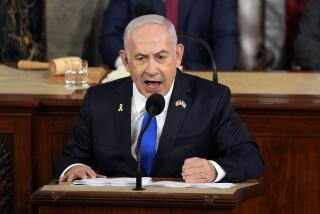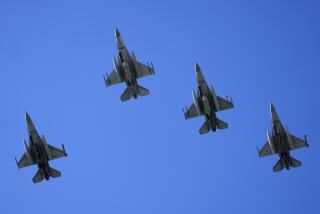Lockheed Could Reap a Windfall in F-117 Rebirth
In a windfall for Lockheed Corp. that seemed improbable until this week, a House-Senate conference committee authorized restarting production of the firm’s F-117A Stealth fighter and provided $560 million for four of the jets in the 1992 defense budget.
The new F-117 production would represent one of the few respites from the relentless budget cutbacks that have afflicted Southern California’s distressed aerospace industry. The plan, which must be approved by an appropriations conference committee and the full Congress, could eventually create several thousand jobs.
The order would go to Lockheed’s Advanced Development Co., better known as the Skunk Works. If production is restarted, the aircraft will be produced at the Skunk Works’ new facilities in Palmdale. The original aircraft were made in Burbank and secretly flown to a desert base inside C-5 cargo jets.
The additional F-117 orders, which could grow to a total of 12 aircraft, are an apparent outgrowth of the marked success the warplane had in bombing Iraqi targets during the Gulf War.
The conference committee, composed of members of the House and Senate armed services committees, agreed Friday to cap new production of the F-117 at 12 aircraft. That cut in half the original plan to produce 24 aircraft, which first surfaced unexpectedly in the Senate Armed Services Committee last July, with the support of committee Chairman Sen. Sam Nunn (D-Ga.). The last aircraft was delivered in 1990.
The Air Force sent nearly its entire fleet of 58 Stealth fighters to the Gulf. While the F-117s made up only 2.5% of U.S. aircraft in the Gulf, they hit 31% of all targets destroyed in the early days of the war, the Air Force said.
Nonetheless, the Air Force has staunchly opposed funding any new F-117 aircraft, citing concerns to Congress that it would result in funding cutbacks of more important new programs, including the B-2 bomber and the F-22 jet fighter.
“We are not particularly excited about investing in technology that is 10 years old or even older,” said Air Force spokesman Col. Larry Greer. “It is an older generation of Stealth and the B-2 represents a later generation.”
The conference committee provided no new funding for B-2 bombers beyond the 15 in production. If that decision stands, the potential economic loss of B-2, which employs about 12,000 workers, would vastly outweigh any gains from the F-117.
“The Air Force has accused us, unjustly I might say, of lobbying Congress to get this aircraft order that the Air Force does not want in the defense budget,” a Lockheed official said. “If this restart is included in the defense bill that President Bush signs, we expect our work force will be increased.”
Lockheed spokesmen declined to say how many jobs would be created by a new order. But during production of the F-117 during the mid-1980s, employment hit a peak of several thousand.
A Senate staffer said that the Senate Appropriations Committee fully supports the F-117 order, but the House Appropriations Committee opposes it.
The plan approved by the conference committee calls for ordering eight aircraft next year for $500 million, which would cut the overall average price of the 12 F-117s to $72 million each.
The genesis of the plan to buy more aircraft came when Air Force officials praised its performance in the Gulf War during hearings last summer, the Senate source said. Air Force officials told the Senate Armed Services Committee that the F-117 was eight to nine times more effective than General Dynamics’ F-16 jet fighters.
“We had to ask ourselves why we were buying 72 F-16s in 1992,” the staffer said. “We have 1,800 F-16s and we only sent 250 of them to Operation Desert Storm. Why would we want to buy even more of them now?”
James Blackwell, an analyst at the Center for Strategic and International Studies in Washington, said: “The F-117 made its own case in Desert Storm. It is obviously more capable than the F-16, but the Air Force wants to push the latest technology into its fleet and they would consider this hindering that effort.”
If the order materializes, it will give Lockheed a significant advantage over other military aircraft rivals by increasing their breadth of programs at a time when other firms are contracting.
“These guys have a chance to swim upstream,” said analyst Howard Rubel of the brokerage C.J. Lawrence, Morgan Grenfell. “Lockheed has the chance of being one of the top aircraft contractors in the 1990s.”
Lockheed could help its case if it can increase the F-117’s payload, which amounts to just two 1,000-pound bombs, Rubel said.
More to Read
Inside the business of entertainment
The Wide Shot brings you news, analysis and insights on everything from streaming wars to production — and what it all means for the future.
You may occasionally receive promotional content from the Los Angeles Times.











